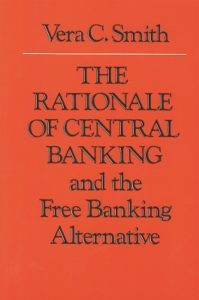Vera Smith: The Contrarian View
By Leonidas Zelmanovitz

In 1936, seven years into the Great Depression, John Maynard Keynes’ General Theory of Employment, Interest, and Money was published. The culmination of Keynes’ theorizing in support of policies of manipulation of money and credit by the state in order to achieve macroeconomic equilibrium came with that book. A central bank, in that context, became the main instrument enabling governments to execute such policies.
With all that going on, what does London School of Economics student Vera Smith do? She writes a doctoral dissertation bringing irrefutable historical evidence contrary to the idea that the manipulation of money and credit is a “new” thing necessary to produce macroeconomic stability. That dissertation became the basis of The Rationale of Central Banking and the Free Banking Alternative,1 her book, also published in 1936.
She tells her readers that state owned (or state supported) monopolies of money issuance had been used by governments for centuries as instruments to achieve political purposes. Those same government interventions in financial markets had also been the source of instability, contrary to what political leaders were saying about Keynes’ prescriptions in response to the popular demand to “do something.” Never ones to let a serious crisis go to waste, unscrupulous politicians worldwide took cover with central bank manipulation of money and credit to seize funds for their political priorities, be them what they may.
That is why we cannot discuss the rationale for central banking without taking into account fiscal policy,2:
- “… it must be admitted that it is almost certain that by far the most powerful reason leading to the maintenance of Government intervention in the banking sphere, at a time when it was on the decline in other industries, was that power over the issue of paper money, whether such power is direct or indirect, is an exceedingly welcome weapon in the armory of State finance” (page 9).
Said differently, central banks historically have performed their roles as money providers, lenders of last resort, and all other instrumental functions in order to better perform its original function, that is, to become a better agent to the state in general and particularly to the fisc.3
We may deduce from Vera Smith that a discussion about the rationale for central banking should, therefore, be divided between justifications in regard to the central bank’s role for the private sector and in regard to its role as a direct arm of the treasury and indirectly of state policy in general.
With this book, Vera Smith seems to be saying, no, Mr. Keynes, the policies you are suggesting are not new, they are not necessary to solve the problems they are purported to solve; most likely, they are part of the cause of the problem. Furthermore, there is an alternative, and that alternative is free banking.
That money does not need to be monopolistically produced or to have its supply regulated by the state can be attested by the fact that money monopolistically produced in one jurisdiction may be used voluntarily by the economic agents in other jurisdictions, as has been the case for millennia. Since the historical evidence demonstrates that the government’s monopoly on money production is not a necessary condition to have a medium of exchange available to the economic agents to facilitate their indirect transactions, that should be discarded as the reason for such a monopoly.4
Thus, the goal of assuring “good” money is also a rationale for central banking that can be falsified; that is, central banking is neither a necessary condition nor a sufficient condition to have good money. You can have good money without central banking and central banking does not guarantee good money.5
We should question whether a central bank with the power to manipulate the money supply either by the inflationary creation of money or by credit is a stabilizer factor in the economy. But, thanks to Vera Smith, we should also ask what does an acceptable rationale for central bank depend on?
It depends on the idea that the banking arrangements are not only of the fractional reserve kind but that there is the implicit or explicit guarantee given by the government that they will come to the rescue of the financial system if needed.
And the bankers may be sure of such a thing, because the government, if nothing else, needs the financial system to float the public debt. If it were not for the need to place public debt in the market, the government would be freer to make clear to the economic agents in general that a rescue of the banks with public funds, real or inflationary, is not to be expected, and therefore the banks would be required to operate much more prudently than otherwise.
To conclude, the argument that central banks are necessary to act as lenders of last resort in order to give stability to the financial system starts from the premise that central banks add more stability than the instability they bring. That presumption is obviously a praesumptio iuris tantum, that is, a rebuttable presumption. Therefore, this assumption only offers a rationale for central banking if proved that the net result of central banking is superior to the result in the absence of central banking, and here comes Vera Smith’s argument for the alternative.
As Vera Smith points out (page 187), if not for the guarantee that the government will intervene to provide liquidity for the banks (a guarantee, by the way, that becomes credible only when the government depends on the banks for its fiscal needs), the banks would be more prudent, and the lender of last resort would not be necessary.
Having attributed the very need of a lender of last resort to the instabilities introduced in the banking system by the privileges granted to them by the government (being incidentally the access to a lender of last resort part of them), that leaves us still with the rationale for central banking based on its function as an instrument for state policy, in particular, state financing.
So, we may return full circle to Vera Smith’s quote at the beginning of this review; central banking cannot be justified by any inherent failure of the capitalist system, not even under fractional reserve arrangements. The problem is that from outside the market comes the coercive powers of government imposing their monetary prerogatives and the power to extract revenues from the monopoly of money production and regulation of credit. The realization that, at the bottom, the rationale for central banks is not an economic one, but a political one, was the way Vera Smith chose to tell whoever cared to pay attention to what she was saying that the king was naked. If banking were allowed to operate freely, without privileges and mandates, there would be no need for central banks, since there would be no need for government interventions in order to stabilize the economy.
Some time ago, it occurred to me that Vera Smith is one of the relatively few female economists who have made an important and original contribution to the science. I do not know why that is, but neither is there any doubt about the originality and importance of her work as presented in The Rationale of Central Banking and the Free Banking Alternative. The fact that the book was first published in 1936 when she was just 24 years old, based on her doctoral dissertation defended the year before, gives us reason to wonder why there are not more authors like her. Again, I have no answer for that, but her courage to consider a contrarian view to the accepted wisdom of the majority of the profession and to the popular mood of her day and age makes her accomplishment even more remarkable.
Footnotes
[1] Vera C. Smith, The Rationale of Central Banking and the Free Banking Alternative.
[2] In writing this book review I drew heavily on arguments first presented in an article entitled “The Fiscal Proviso” (2013) and on my book “The Ontology and Function of Money” (2016).
[3] One may argue that there were no fiscal considerations in play at the creation of the Federal Reserve System (FRS) as the fourth central bank in the United States, but Vera Smith offers evidence to show there were (page 163); true or false as that may be, that does not diminish the fact that the previous three central banks (The Bank of North America, The First Bank of the U.S., and the Second Bank of the U.S.) were created primarily with that purpose in mind and that the bank created in 1913 was completely mobilized as an agent of the Treasury by 1917 and has performed that role ever since. In regard to the Bank of England, however, there is no doubt that not only was it established in 1694 in order to provide funds to the British Crown but also that privileges such as the management of the National Debt, the acceptance of its notes in payment of taxes, and later the granting of legal tender status to them, among others, were extended in order to facilitate the bank’s purpose as an instrument of War finance.
[4] Even after the establishment of a mint in the United States, foreign coins had legal tender status as late as 1854 (the Spanish Silver Dollar retained that status until 1857), demonstrating that a monopoly of money supply is not a necessary requirement to have money supplied. The relative merits of providing the supply of money either monopolistically or competitively is a different discussion.
[5] All the historical examples of debasement, suspension of convertibility and inflation demonstrate beyond doubt that central banking does not guarantee good money, but good money being supplied without central banking requires some explanation. The argument here is that in the absence of forced tender, the economic agents will choose the money that best suit their necessities, it may be the U.S. Dollar in Panama or Ecuador, or the Spanish Silver Dollar during colonial times and later in the Antebellum United States of America. It is not an argument that there will always be a better money available than the one provided by the central bank, but that the monopoly of the money supply as embodied by the central banks worldwide, because of the attribute of being a monopoly, precludes the possibility of the economic agents to use a better money that may be available.

